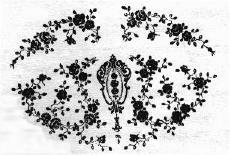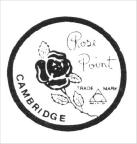Rose Point Design ... Now On Glassware
by Mark A. Nye
Issue No. 271 - November 1995
"Presaging a wide vogue in the decorative design called 'Rose Point,' the Cambridge Glass Co. announces for 1935 selling, their 'Rose Point' etched design on glassware. As developed for glass adornment, the design, taken from a rare piece of old lace, makes an unusually attractive decoration. 'Rose Point' long has been the favorite lace design for bridal trousseau.... The Cambridge Glass Co. has applied for a patent design on 'Rose Point' etched glassware from the United States Patent Office.... 'Rose Point' in lace has been an overwhelming popular favorite for bridal costumes because it is based on the rose and accompanying rose leafage. In the design, as applied to glassware in the form of an etching by the Cambridge Glass Co., the depiction of a rose stands out clearly. The 'Rose Point' on glass is in panel form with small medallions, showing rose buds, alternating between the wide panels."
The preceding was extracted from an article, originally appearing in
the November 1934 issue of China, Glass and Lamps (CGL),
 that introduced the etching Rose Point to the trade. The introduction
of Rose Point was a rather routine event for Cambridge, one to which no great
significance was placed. Granted it was a major etching but none the
less only one more in a line of previously successful Cambridge
undertakings. So routine was the introduction of new etchings, Mr.
Bennett, owner and President of the Cambridge Glass Co., spent the last
several months prior to the introduction of Rose Point in England and
Europe. Whether or not anyone at the time foresaw the extent of the
popularity Rose Point would achieve remains an unanswered question but
indications are the answer is no. For several years after its
introduction, Rose Point was a smaller line than Elaine, indicating
some time passed before Rose Point came into its own and became the
premier Cambridge etching.
that introduced the etching Rose Point to the trade. The introduction
of Rose Point was a rather routine event for Cambridge, one to which no great
significance was placed. Granted it was a major etching but none the
less only one more in a line of previously successful Cambridge
undertakings. So routine was the introduction of new etchings, Mr.
Bennett, owner and President of the Cambridge Glass Co., spent the last
several months prior to the introduction of Rose Point in England and
Europe. Whether or not anyone at the time foresaw the extent of the
popularity Rose Point would achieve remains an unanswered question but
indications are the answer is no. For several years after its
introduction, Rose Point was a smaller line than Elaine, indicating
some time passed before Rose Point came into its own and became the
premier Cambridge etching.
The previously cited CGL article closed with the paragraph that follows.
"Production of Rose Point glassware has been started at the Cambridge Glass Co. in preparation for early 1935 selling. The company expects to be able to start deliveries before December 15. Rose Point will be one among new designs and shapes to be brought out by the Cambridge Glass Co. for 1935 introduction."
Rose Point was on display when the 1935 Pittsburgh Trade Show opened January 7. It was an immediate success for Cambridge, became a staple of the Cambridge line, and continued in production until the furnaces were extinguished for the good in 1959. Some of the success can be attributed to the fact there was and is a sterling flatware Rose Point pattern, made by Wallace Silver Company. At the time the etching was introduced, there was also a Rose Point china pattern, made by the Pope-Gosser China Co. Leading department and jewelry stores set up elaborate displays of these coordinating items. Cambridge augmented these displays with a deluge of advertising featuring Rose Point.
Quoting from the February 1935 issue of CGL:
"New shapes for the fascinating Rose Point decoration ... tall stemmed styles with flat pieces to match ... also a distinctive shape with a blown bowl, on a conical pressed base which carries the Rose Point design in embossed effect." Clearly the latter describes what we now call Pressed Rose Point stemware.
From the same February 1935 issue of CGL comes this caption to an illustration:
"The Glassware in the center illustration is from the Cambridge Glass Co. and shows their new No. 3106 (stemware) shape on which is used the Rose Point (copyrighted) etching. The etching has been designed as companion glassware to match a well-known china and silver line. Cambridge is making this in a full line of crystal stemware, flatware and novelties. The etching, which is the newest this factory has brought out has a fine, lace-like quality and is beautifully detailed."
In a description of new lines from Cambridge appearing in the August 1935 CGL issue was this statement: "Popular Rose Point design done in gold on series of fancy pieces and two shapes of stemware."
A year later, the October 1936 issue of CGL contained a picture of Rose Point Gadroon stemware with this caption:
"Cambridge Glass Co. is showing a new line of gold decorated Rose Point glass on Carmen (red) that is available in full stemware, and accessory pieces such as bowls, candlesticks, etc. As will be seen from the pieces pictured, the stemware is featured with a ruby bowl and Rose Point decoration with crystal stem and foot. This is the very newest thing Cambridge has done."
The Rose Point design itself will vary from piece to piece, mainly in the size of the etching. The etching will be scaled down on items such as wines and cordials and proportionally enlarged on such items as bowls, plates and vases. A limited number of items with small surfaces, such as an individual ash tray, or the bottom of some covered pieces will have the vine only, lacking the medallion found on most pieces. Some pieces may have only three medallions while others will have four or five. There will be other variations of the etchings such as the one seen on No. 3400 line cups. These have only the top part of the medallion ending in the raised corner which extends from the bottom of the cup.
Stemware was included in the Rose Point line from the beginning. The stemware to etched Rose Point was 3500 or Gadroon followed by No. 3106, Pressed Rose Point and No. 3121. There was one other full service stemware line listed on a Cambridge price list as having been decorated with the Rose Point etching and it is Pristine. The January 1940 price list contained a listing for nine pieces of Pristine stemware etched Rose Point and decorated with a gold edge. No listing for this combination has been found elsewhere and until a couple of years ago, a piece had not been seen. A cocktail is now known.
No. 3011 or Nude table goblets, champagnes and cocktails etched Rose Point and gold encrusted are known to exist. A single set has been seen and may have been a special order as no Cambridge listing for this combination has been located. Following the liquidation of the Imperial Glass Co., NCC, Inc. acquired all the remaining Rose Point etching plates and found among them were the plates used when these items were manufactured.
Rose Point is seldom seen on colored blanks and what is found will be on Amber, Carmen, Crown Tuscan and Ebony blanks. In most instances, it will be gold encrusted. Amber and Carmen Rose Point probably dates prior to 1940. Rose Point on Crown Tuscan spans the years from the late 1930s to the early 1940s while Ebony pieces seem to be from the early 1940s. Contrary to gold decorated crystal Rose Point, colored Rose Point is greatly desired by the advanced collector and is in short supply. Hence such items are infrequently seen for sale and when they do appear, command premium prices.
Other manufacturing companies, from time to time, purchased Cambridge glass, plain and decorated, for use in their lines. Such companies included the silver manufacturer, R. Wallace & Sons, and one or more lighting companies. Rose Point decorated wares were no exception and you will find Rose Point with sterling silver fittings. Lamps made from gold encrusted Rose Point etched Crown Tuscan urns are known. In all probability, Cambridge did not assemble such lamps, they simply produced the glass and decorated it. Once the glass left the factory, Cambridge had no further involvement.
Among the more unusual glass and silver combinations are goblets consisting of glass bowl etched Rose Point with Wallace Sterling Silver stem and foot embossed with the Rose Point design. From time to time you will also find silver trays or coasters with Rose Point etched glass inserts.
Cambridge honored the Rose Point line through the distinction of
having its own specialty trademark, an honor given only to a few lines.
Very little information regarding the Rose Point trademark exists but
the presence of the "triangle C" indicates it was probably not used
after 1937. Since the line was not introduced until 1935, this mark was
probably only used for two years or less. The original consisted of
white printing on rose colored paper.  From time to time, a piece of glassware is found
bearing the Rose Point label. However, in most instances the condition
of the label prevents obtaining a copy whose quality would enable
reprinting. The illustration shown at right is a recreation of the
label. It is not identical to the original in that the components are
not in the same proportion to each other as they were in the
original.
From time to time, a piece of glassware is found
bearing the Rose Point label. However, in most instances the condition
of the label prevents obtaining a copy whose quality would enable
reprinting. The illustration shown at right is a recreation of the
label. It is not identical to the original in that the components are
not in the same proportion to each other as they were in the
original.
The other illustrations accompanying this article are a catalog page and a print from the etching plate for the bottom of the 3400/200 three part relish. The catalog page, which shows Rose Point etched No. 3121 stemware, is from the catalog issued in late 1956 and commonly referred to as the 1956-58 catalog. The etching plate print illustrates how allowances were made for the three sections of the relish and the dividers. No etching was done under the dividers; the pattern only appearing in each of the three sections.
A great deal of additional information regarding Rose Point, including a listing and illustrations of all the pieces ever etched Rose Point, will be found in the book ROSE POINT and its companion value guide published by NCC, Inc. This is a book the Rose Point collector should not be without.
